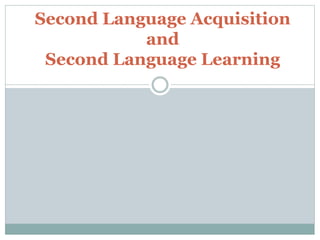
Second Language Acquisition and Learning Factors
- 1. Second Language Acquisition and Second Language Learning
- 2. What is it? Second language acquisition (SLA) is a process where a second language is learned or acquired, in addition to having a first language
- 3. How long does it take? The length of time it takes to acquire English varies from learner to learner. It can take from “…four to seven years or more.” (Klinger, Hoover, & Baca, 2008, 19)
- 4. What’s the difference? There is a difference between acquisition and learning Second Language Acquisition is a subconscious learning process Second Language Learning involves a conscious process Although, many in education use the two terms synonymously
- 5. Factors that influence SLA Motivation First language experiences Language distance and attitude Access to the language Age of acquisition Personality and learning styles Peers and role models Quality of instruction
- 6. Motivation Motivation comes in two forms; integrative and instrumental Integrative ELL’s positive attitude towards native-English speakers ELL’s aspirations to become a member of the English speaking community ELLs will find more success when want to integrate into the new target society, Linked to long-term success in ELLs Instrumental Tied to a social or economic reward for learning English Often times with little social integration ELL is trying to gain something practical or concrete from learning English Both integrative and instrumental motivations contribute to successful development of English language proficiency
- 7. First Language Experiences First language can impact the learning of English vocabulary, pronunciation, and grammar, as well as language structure and use Positive transfer can increase the rate at which English is learned Negative transfer can impede its growth Native language proficiency can affect acquisition of English The more academic knowledge and the more proficiency ELLs are in their first language, will aid in learning a second language (Walqui, 2000)
- 8. Language distance and attitude Depending on their native language, ELLs may have an easier or more difficult time learning English The more similar English is to the ELL’s native language, the easier time they will have learning the language The ELL’s language attitudes toward school, peers, and the community can effect learning English Attitudes can have both positive and negative effects on English progress Learning English is additive and not subtractive It does not necessary mean losing the first language, but rather learning an additional one
- 9. Access to the language ELLs will have access to the language at school, but support from home will increase their success While some educators may advocate that parents of ELLs speak English at home, it is more important for ELLs and their parents to value and maintain their native language in order to keep the lines of communication open
- 10. Age of Acquisition In general, when it comes to pronunciation, experts agree that the development of pronunciation is highly depending on the age at which the learner begins learning English It is believed that if an ELLs learns English before puberty, the learner will attain a native-like accent, whereas ELLs who learn English after the onset of puberty, will most likely always speak English with a marked accent
- 11. Personality and Learning Styles ELLs come from a variety of different and diverse background Learning a second language varies greatly from individual to individual This is due in part in individual difference in analytic orientation or global orientation Analytically oriented ELLs will breakdown learning English into words and sentences Globally oriented ELLs will use patterns of the language to gain meaning
- 12. Peers and Role Models ELLs in their teens will be strongly influenced by their peers in order to establish a sense of belonging It is essential for ELLs to have role models who are both positive and realistic that demonstrate successful bilingualism This connection can also be made through literature and personal experiences Role models will aid the ELL in developing an understanding of their own successes and challenges
- 13. Quality of Instruction ELLs are not learning English from memorization or drills ELLs learn through meaningful interaction inside and outside of the classroom Although teachers cannot control the interaction outside of the classroom In the class, teachers can foster the growth and development of their English language learning through their own instruction in the classroom They can create a classroom environment that the rich in language and collaborative in nature, rather than rely on lecture and recitation during instructional activities
- 14. The End